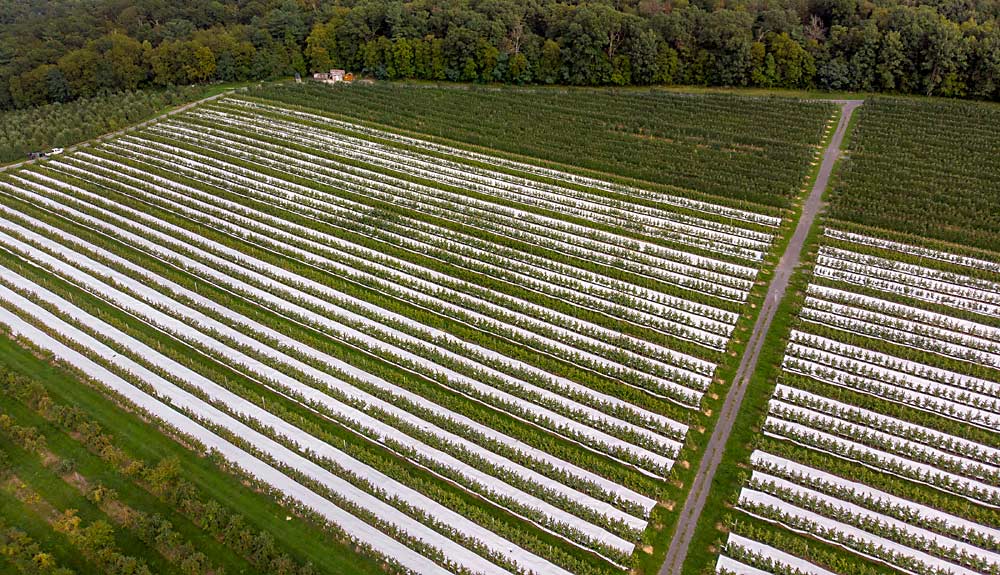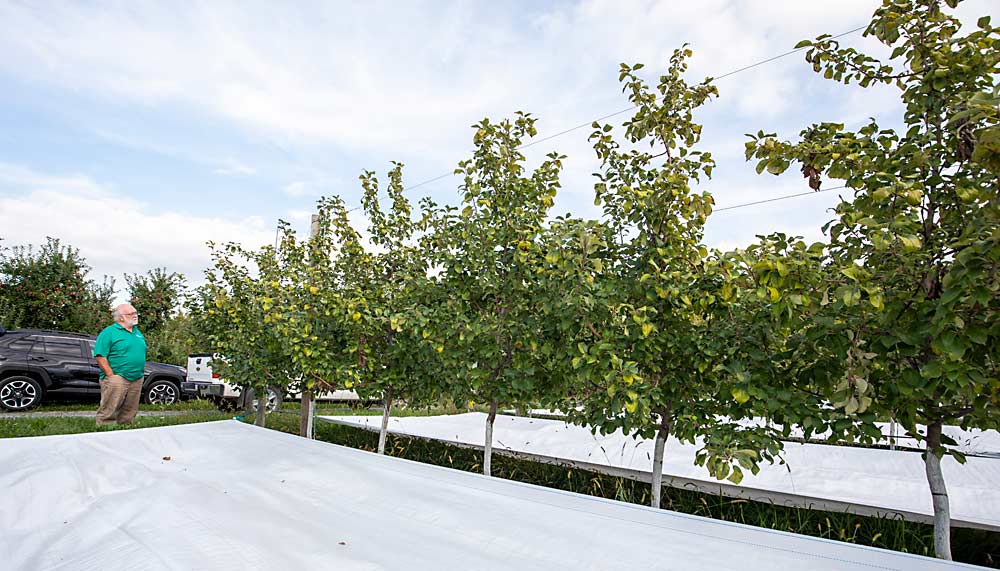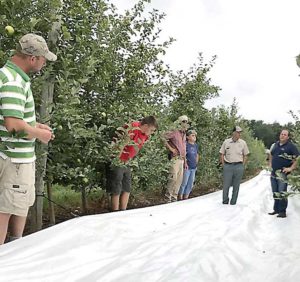
Honeycrisp has a hard time coloring in warm and humid southern Pennsylvania. Older plantings of the original strain of Honeycrisp, especially, struggle mightily to get the right amount of red on their skin, making them less than desirable to retailers. That’s why a few of the region’s growers are turning to reflective fabric.
Reflective fabric won’t “make a green apple red” — that is, it won’t completely solve the coloring problem — but it can enhance the background color dramatically, as well as enhance the red color, said Joy Cline, chief operating officer and farm manager of Bear Mountain Orchards in Aspers, Pennsylvania. Bear Mountain has been using Extenday to color Honeycrisp and other varieties for a couple of years now.
“It doesn’t take many Honeycrisp to go from a juice bin into a packed box to recoup your Extenday cost,” Cline said.
Bear Mountain has about 40 acres’ worth of Extenday, enough to cover its Honeycrisp plantings. Many of those plantings are the original strain of Honeycrisp planted a dozen years ago. They don’t color well. By reflecting the sun’s light back up into the tree canopy, Extenday helps enhance the background color enough to appeal to retailers, Cline said.
Most of the light is targeted toward the apples in the lower third of the canopy, where help with coloring is most needed, said University of Maryland assistant professor Macarena Farcuh.

Farcuh has been evaluating Bear Mountain’s Extenday results since 2020. Poor fruit coloration, especially on Honeycrisp, is a problem for Maryland as well as Pennsylvania growers. Retailers want at least 50 percent red coloration, but there’s not enough direct sunlight or cool night temperatures in the region, two of the factors that contribute to red coloring on apples. The problem is even worse when summer is warmer than usual, she said.
Farcuh said placing and removing the Extenday fabric between rows is laborious. The covers have to be deployed three to four weeks before anticipated harvest and stay in place throughout picking. They can be used for up to seven years, she said.
When Bear Mountain started using the fabric, it took seven or eight workers to place it and remove it. With experience, the task is down to three people. During harvest, they roll the fabric to one side so the tractor and wagons can get through, Cline said.
Cline got the idea to use Extenday a few years ago, after talking with New York growers who use it. 2021 was the first season Bear Mountain put Extenday under EverCrisp plantings, as well as Fuji. They saw improved coloring in both varieties. The Premier Honeycrisp strain also colored well with Extenday, she said.
Along with increasing red color in apples, they’ve observed that Extenday has the potential to advance ripening, Farcuh said. That can be a good thing in a region where growers generally delay picking until apples redden, which can often lead to overripe fruit. She said Extenday is a useful tool that can help growers harvest fruit at the correct time with the correct color. She also wants to study the interactions between Extenday and plant growth regulators such as ReTain (aminoethoxyvinylglycine) and Harvista (1-methylcyclopropene), which delay ripening.
Penn State University professor Jim Schupp has been studying Extenday with Farcuh. He said reflective fabric is a good way to get more sunlight into the lower canopy for growers who already effectively prune and manage mineral nutrients but who still need to increase red color in their apples. Pneumatic defoliation is another option, he said.
—by Matt Milkovich







Leave A Comment